The surprising reason why the new MacBook Pro doesn't have (much) more battery life
There's a big hint in the photo above.

Everybody wants more battery life. And sometimes, you can get it -- but if you were expecting many hours of additional battery life from a new 15-inch MacBook Pro, you'll be disappointed.
Apple quotes a 10 hour battery life for the new MacBook Pro, whether you pick the 13- or 15-inch model. That's not just respectable -- it's good, particularly for a laptop with a quad-core CPU. But last year, the MacBook Pro got 9 to 10 hours. It's not a lot more.
Part of that's because the new MacBook Pro is thinner, and has a smaller battery pack inside. But you know what? Even if Apple wanted to make the battery bigger, the company couldn't do it.
I know that's a bold claim, and Apple's engineers have done seemingly impossible things before. But I'm not talking about science -- I'm talking about the law. It's illegal to carry a laptop on an airplane with a battery capacity greater than 100 watt-hours -- and last year's 15-inch MacBook Pro already had a 99.5 watt-hour power pack.
I'm not sure why 100 watt-hours is the limit, and not 99 or 103, but it's been the rule in many countries (including the US) for a number of years. Lithium-ion batteries are considered hazardous materials, because of their ability to explode, and so generally you can only carry one internal up-to-100Wh battery and a couple of up-to-160Wh removable spares on a flight now.
See those giant silver palmrests? It's all battery under there.
Of course, a bigger battery isn't the only way to improve battery life. Engineers can swap out circuits for more efficient ones, or improve the display. Apple did both with the new MacBook Pro, in fact, with new Intel processors and a 30 percent more efficient backlight for its high-res screen.
Apple might have gone even a bit further if it had access to Intel's latest chips -- the Kaby Lake ones -- but they aren't yet ready in the more powerful configurations Apple prefers for its MacBook Pro. (They're due early next year.)
MacBook batteries, compared
| Battery life (mfgr. estimate) | Capacity | Charger | |
| MacBook Pro (15-inch, 2015) | 9 hours wireless web | 99.5 watt-hour | 85W MagSafe 2 |
| MacBook Pro (15-inch, 2016) | 10 hours wireless web | 76.0 watt-hour | 87W USB-C |
| MacBook Pro (13-inch, 2015) | 10 hours wireless web | 74.9 watt-hour | 60W MagSafe 2 |
| MacBook Pro (13-inch, 2016 w/Touch Bar) | 10 hours wireless web | 49.2 watt-hour | 61W USB-C |
| MacBook Pro (13-inch, 2016) | 10 hours wireless web | 54.5 watt-hour | 61W USB-C |
| MacBook (12-inch, 2016) | 10 hours wireless web | 41.4 watt-hour | 29W USB-C |
If Apple had opted to stick with a 99.5Wh battery instead of shrinking down the computer, perhaps we'd be looking at 12 hours on a charge. (In an earlier version of this article, that's exactly what I predicted wouldn't happen, and I'll be glad to be proven wrong.) This way, the company has a bit more headroom to improve battery life over the next few years, without hitting that 100 watt-hour wall.
Check out all of today's Apple news here.
Update, 5:45 p.m. PT: Rewritten after Apple's event, to reflect that Apple actually managed to reduce the size of the battery. Originally, the author predicted the 100Wh limit would mean minimal battery life gains.

